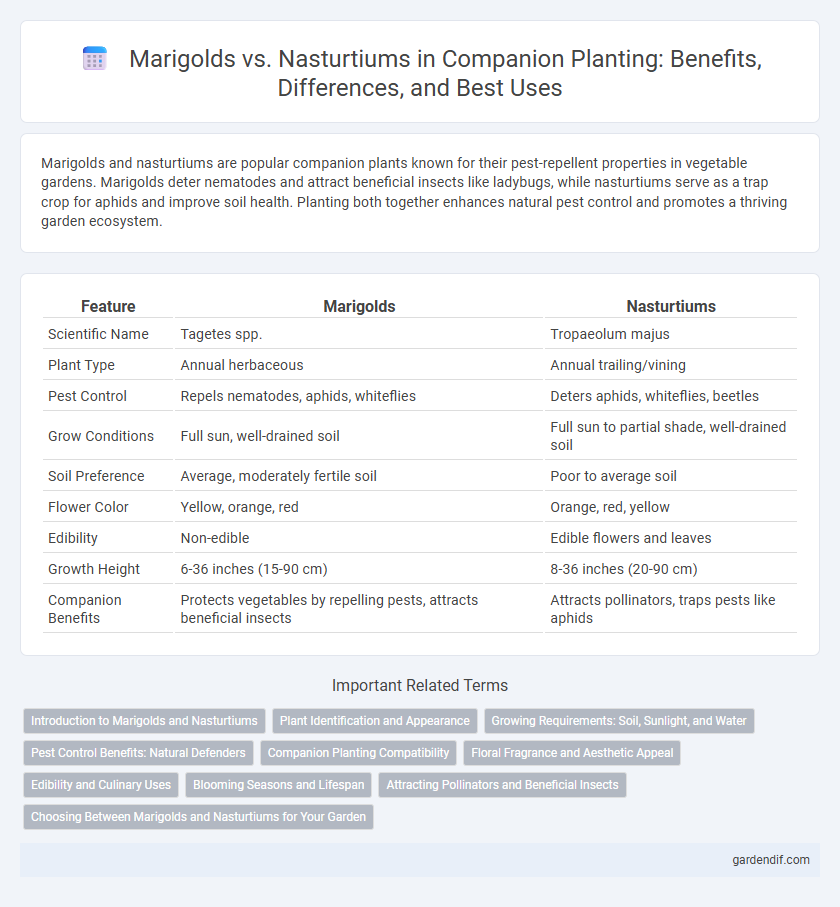
Marigolds vs nasturtiums Illustration
Marigolds and nasturtiums are popular companion plants known for their pest-repellent properties in vegetable gardens. Marigolds deter nematodes and attract beneficial insects like ladybugs, while nasturtiums serve as a trap crop for aphids and improve soil health. Planting both together enhances natural pest control and promotes a thriving garden ecosystem.
Table of Comparison
| Feature | Marigolds | Nasturtiums |
|---|---|---|
| Scientific Name | Tagetes spp. | Tropaeolum majus |
| Plant Type | Annual herbaceous | Annual trailing/vining |
| Pest Control | Repels nematodes, aphids, whiteflies | Deters aphids, whiteflies, beetles |
| Grow Conditions | Full sun, well-drained soil | Full sun to partial shade, well-drained soil |
| Soil Preference | Average, moderately fertile soil | Poor to average soil |
| Flower Color | Yellow, orange, red | Orange, red, yellow |
| Edibility | Non-edible | Edible flowers and leaves |
| Growth Height | 6-36 inches (15-90 cm) | 8-36 inches (20-90 cm) |
| Companion Benefits | Protects vegetables by repelling pests, attracts beneficial insects | Attracts pollinators, traps pests like aphids |
Introduction to Marigolds and Nasturtiums
Marigolds (Tagetes spp.) are vibrant annual flowers known for their pest-repellent properties, often used in companion planting to protect vegetables like tomatoes and beans. Nasturtiums (Tropaeolum majus) provide natural pest control by attracting aphids away from other plants, while also enhancing soil health through nitrogen fixation. Both marigolds and nasturtiums contribute to biodiversity and garden pest management, making them valuable companions for a thriving garden ecosystem.
Plant Identification and Appearance
Marigolds (Tagetes spp.) feature bright, pom-pom shaped flowers in shades of orange and yellow with finely divided, fern-like leaves. Nasturtiums (Tropaeolum majus) display vibrant, trumpet-shaped flowers in red, orange, or yellow hues, accompanied by round, shield-like leaves with prominent veins. The distinct floral structures and leaf morphologies of marigolds and nasturtiums facilitate easy identification for gardeners selecting companion plants.
Growing Requirements: Soil, Sunlight, and Water
Marigolds thrive in well-drained, moderately fertile soil with full sun exposure and require consistent watering to keep the soil evenly moist but not waterlogged. Nasturtiums prefer poorer, well-drained soil and can tolerate partial shade, making them more adaptable to varying sunlight conditions; they need less frequent watering, allowing soil to dry out between sessions. Both plants benefit from careful water management to prevent root rot and promote vibrant blooms.
Pest Control Benefits: Natural Defenders
Marigolds and nasturtiums serve as effective natural defenders in pest control within companion planting strategies. Marigolds release thiophenes that repel nematodes and certain insects, while nasturtiums attract aphids away from valuable crops, acting as trap plants. Both plants enhance garden health by reducing the need for chemical pesticides through their natural pest-suppressing properties.
Companion Planting Compatibility
Marigolds and nasturtiums both excel as companion plants due to their pest-repellent properties, with marigolds effectively deterring nematodes and certain beetles, while nasturtiums attract aphids away from vegetables. Their complementary pest control enhances garden health by reducing the need for chemical pesticides, making them ideal partners in vegetable beds and flower borders. Mixing these plants optimizes biodiversity and supports beneficial insect populations, contributing to sustainable gardening practices.
Floral Fragrance and Aesthetic Appeal
Marigolds emit a strong, spicy scent that can deter pests while adding vibrant orange and yellow hues to garden beds. Nasturtiums offer a milder, slightly peppery fragrance complemented by bright red, orange, and yellow flowers that enhance visual interest. Both plants elevate garden aesthetics, with marigolds providing bold color contrasts and nasturtiums offering delicate trails and edible blooms.
Edibility and Culinary Uses
Marigolds and nasturtiums both enhance culinary dishes with their edible flowers and leaves, but nasturtiums offer a peppery flavor ideal for salads and garnishes. Marigold petals provide a slightly citrusy and bitter taste, often used to add color and subtle zest in soups and rice dishes. Both plants contribute nutritional benefits, including vitamins A and C, making them flavorful and healthful additions to various recipes.
Blooming Seasons and Lifespan
Marigolds typically bloom from late spring through fall, providing vibrant color throughout the growing season, while nasturtiums bloom primarily in summer and early fall. Marigolds are annuals with a lifespan limited to a single growing season, whereas nasturtiums can behave as annuals or perennials depending on the climate. Selecting these companion plants based on their overlapping blooming seasons enhances garden aesthetic and continuous floral interest.
Attracting Pollinators and Beneficial Insects
Marigolds attract a wide variety of pollinators such as bees and butterflies with their bright orange and yellow blooms, enhancing garden biodiversity. Nasturtiums release a strong scent that draws beneficial insects like predatory wasps and ladybugs, which help control pests naturally. Both plants serve as effective companions by boosting pollination and supporting pest management in vegetable and flower gardens.
Choosing Between Marigolds and Nasturtiums for Your Garden
Marigolds offer pest-repellent properties effective against nematodes and aphids, making them ideal for vegetable gardens where plant protection is crucial. Nasturtiums attract beneficial insects like predatory wasps and act as trap crops for aphids, enhancing biological pest control through companion planting. Selecting between marigolds and nasturtiums depends on desired pest management strategies and the specific plants in your garden ecosystem.
Marigolds vs nasturtiums Infographic

 gardendif.com
gardendif.com